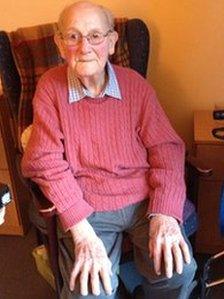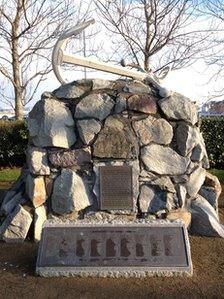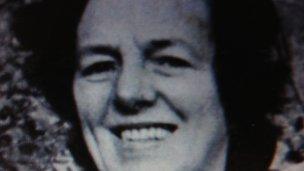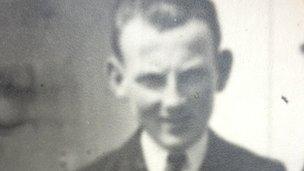Princess Victoria sinking remembered 60 years on
- Published

John McKnight, from Larne, is one of the few remaining survivors
Sixty years ago, the MV Princess Victoria sank off the County Down coast in treacherous weather, with the loss of 133 lives.
Stop anyone on the street and ask them about Titanic, chances are they will know something about the maritime tragedy.
But despite the fact that no women or children survived the sinking of the Princess Victoria, you might get a more quizzical look.
Now the grief, heroism and the impact this tragic story had on communities in Northern Ireland and Scotland is retold in a BBC Radio Ulster documentary on Sunday.
Almost 60 years ago this sea disaster - one of the worst to happen in British coastal waters - dominated the headlines and devastated families and communities in Larne, Stranraer and further afield.
The omens were not good on the day the ferry sank - 31 January 1953.
Parts of western Europe and the UK were in the grip of freak weather from the north Atlantic.
Severe gales battered coastlines and floods hit many areas, killing hundreds of people.
It was in these treacherous conditions that the Princess Victoria set sail from Stranraer.
Larne man, John McKnight, 92, is one of the few remaining survivors. He was chief cook on the ferry and remembers that day vividly.
"I started work at 5.30am and the train from London arrived (in Stranraer) at 6am. Everything had to be prepared for breakfast, we served that to the passengers before setting sail. The ferry proceeded up Loch Ryan and soon we discovered that there was a severe gale blowing," he recalled.
Fate sealed
At the helm of the Princess Victoria that day was 55-year-old Captain James Ferguson. An experienced seaman, he had worked on the Larne - Stranraer route for many years.
Captain Ferguson's troubles started when he steered the ferry out of Loch Ryan.
Jack Hunter, a retired school teacher from Stranraer, who has written about the tragedy, explained what happened next.
"Out of the shelter of the loch, Captain Ferguson discovered that the sea was much worse and perhaps with a change of direction, the ship was having more difficulty," he said.
"For one reason or another, the captain decided to try turn back and head for Stranraer. It was at this point that the ferry had a calamitous encounter with a large wave, which stove in the stern doors."
This brush with mother nature at her worst was, ultimately, to seal the fate of the Princess Victoria.

A memorial to those who lost their lives in the Princess Victoria tragedy stands in Stranraer
With the stern doors irreparably damaged, water flooding the car deck and inadequate drainage on board, Captain Ferguson decided the best course of action was to try and steer the ship towards Northern Ireland.
Passengers and crew
As disaster unfolded, the 127 passengers and 49 crew members found themselves locked in a terrible and increasingly impossible struggle for survival.
On board were people from all social classes.
Families with young children, servicemen, Short Brothers workers from the company's Scottish base and two politicians - the Northern Ireland deputy prime minister, Maynard Sinclair and Sir Walter Smiles, the north Down MP. Both men died when the ship went down.
At 09:46 GMT, the Princess Victoria sent its first request for help. David Broadfoot, the ship's radio officer, was not supposed to be working that day but had swapped shifts with another crew member.
Stephen Cameron, author of a book on the Princess Victoria tragedy, said David Broadfoot was posthumously awarded the George Cross for his heroic actions.
Heroine
"He stayed in his cabin broadcasting continuously, at one stage he even apologised to radio stations (that were picking up his signals) for the poor quality of his Morse code. David's last message was sent as the ship went under," he said.
In those final traumatic hours, many other people showed fortitude and compassion in the face of certain death.
One of them was Castlerock woman, Nansy Bryson, who has been called the "heroine of the Princess Victoria".
She worked as a missionary in Kenya and was back home with her husband and three children, visiting relatives.

Nansy Bryson was called the "heroine of the Princess Victoria"
Nansy had travelled to Scotland for some meetings and was returning to Northern Ireland on the ferry. Her daughter, Margaret Njonjo, hasn't talked about the tragedy in public before and shared her pride in her mother.
"She was one of the bravest women on board who whispered words of comfort to other passengers and led them in singing a hymn. She also tried to help a three year old child into one of the lifeboats but failed to do so, going under (the water) herself in the process," Margaret said.
"My sisters and I are glad to know she found immense strength in her own faith, to the point of being able to help others."
Rescue attempt
When Captain Ferguson made the final call to abandon ship, eyewitnesses say he was at the bridge as the Princess Victoria went under. It happened just five miles off the Copeland Islands and within sight of the north Down coast.
Some passengers and crew were able to reach the ship's lifeboats although, tragically, one carrying women and children crashed against the side of the ferry, throwing everyone into the icy waters. All of them died.
The frantic search for survivors involved steamers, trawlers, a naval boat and the Donaghadee lifeboat, the Sir Samuel Kelly. Its crew eventually plucked 33 men to safety. Bravery medals were awarded to many for their valiant rescue efforts that day.
Only 44 men survived the sinking of the Princess Victoria - more than three times that number perished. For families, especially in Larne and Stranraer, the news that a loved one had died was too much to bear.
Captain Ferguson's son, Jim, who was 18 when the tragedy happened, remembers the show of support from his father's colleagues.

Jack Peoples was the youngest crew member to die
"A few of the sailors who survived, came to our house over the next few days to speak to my mother. She appreciated it very much, particularly in times of difficulty and stress for them," Jim remembered.
Emotion
"I still feel his loss, very much so, I loved my father."
When Betty Crawford thinks of her brother Jack Peoples, it is often with raw emotion. At 16, the Larne teenager was the youngest crew member to die.
"(On the day of the tragedy) my mum disappeared. I found her in the garden where she was praying to God to please bring back his body. And God answered her prayer because she got his body back," Betty said.
"Jack's was one of the first funerals to take place, I remember throngs of people there and men with tears running down their cheeks. There was a numbness about it all and disbelief."
Two months after the disaster, a court of inquiry was convened in Belfast. A verdict was reached that the Princess Victoria was not a seaworthy ship, because of the inadequate strength of the stern doors and a lack of drainage on its car deck.
On two previous occasions - in 1949 and 1951 - these same design faults had caused problems on the ferry. Jack Hunter believes if they had been fixed back then, things might have been very different.
"Most certainly, it is a disaster that could have, and should have been avoided. The problems were discovered, they were known to be there, one assumes they were reported through official channels, yet nothing was done about them," he said.
Whatever the causes of the Princess Victoria sinking to a watery grave on that stormy Saturday afternoon in January 1953, the passing of time has not erased the sorrow felt by many, whose loved ones went down with the ship.
They are commemorated every year at services in Larne, Stranraer and in Donaghadee - and on the forthcoming 60th anniversary, the overriding sentiment will remain the same.
Never forget.
You can listen to The Princess Victoria Disaster on Radio Ulster at 13:30 GMT on Sunday 27 January.